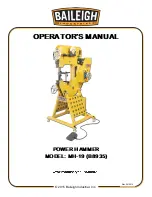
24
Safety Instructions for Oscillating Edge Belt/ Spindle
Sander (continued)
Inspect your workpiece make sure
there are no nails or foreign objects in
the part of the workpiece to be
sanded.
Plan the way you will hold the
workpiece from start to finish.
Reduce the risk of awkward opera-
tions and hand positions where a
sudden slip could cause finger or
hand to move into a sanding surface.
Don’t overreach. Maintain balance
and footing.
Keep face and body to one side.
Stay out of line with a possible throw-
back.
Plan your work to reduce the risk of
THROWBACKS - when the work-
piece catches the sanding drum and
is torn from your hands:
• Make sure there’s no debris
between the workpiece and its sup-
ports.
• When sanding irregularly shaped
workpieces, plan your work support
so it will not slip and be pulled from
your hands.
• Use extra caution with large, very
small or awkward workpieces.
• Never use this tool to finish pieces
too small to hold by hand.
• Use extra supports (tables, saw
horses, blocks, etc.) for any work-
pieces large enough to tip when not
secured to the work surface.
• Never use another person as a sub-
stitute for a table extension, or as
additional support for a workpiece
that is longer or wider that the basic
sander table, or to help feed, sup-
port or pull the workpiece.
• Sand only one workpiece at a time.
• Clear everything except the work-
piece and related support devices
off the table before turning the
sander on.
• Always feed workpiece from left to
right against the direction the drum
sleeve is rotating.
• Do not use drums, sanding sleeves
or belts which show visual signs of
wear such as grooves, tears or rips.
WARNING: Don’t let familiarity
(gained from frequent use of
your sander) cause a careless
mistake. A careless fraction of a
second is enough to cause a
severe injury.
When Sander is Running
Before starting your work, watch the
sander while it runs. If it makes an
unfamiliar noise or vibrates exces-
sively, Stop Immediately. Turn the
sander off. Unplug the sander. Do not
restart until identifying and correcting
the problem.
Never leave tool running unat-
tended.
Before using the sander, make sure
the sanding belt turns clockwise,
when viewed from above.
Keep children away. Keep all visi-
tors a safe distance from the sander
and workpiece.
Don’t force tool. It will perform better
and safer at its designed rate. Press
workpiece against the sanding sleeve
or belt hard enough to begin sanding
without bogging down or binding spin-
dle.
Summary of Contents for EB4424
Page 1: ...OSCILLATING EDGE BELT SPINDLE SANDER ...
Page 35: ...35 Notes ...













































